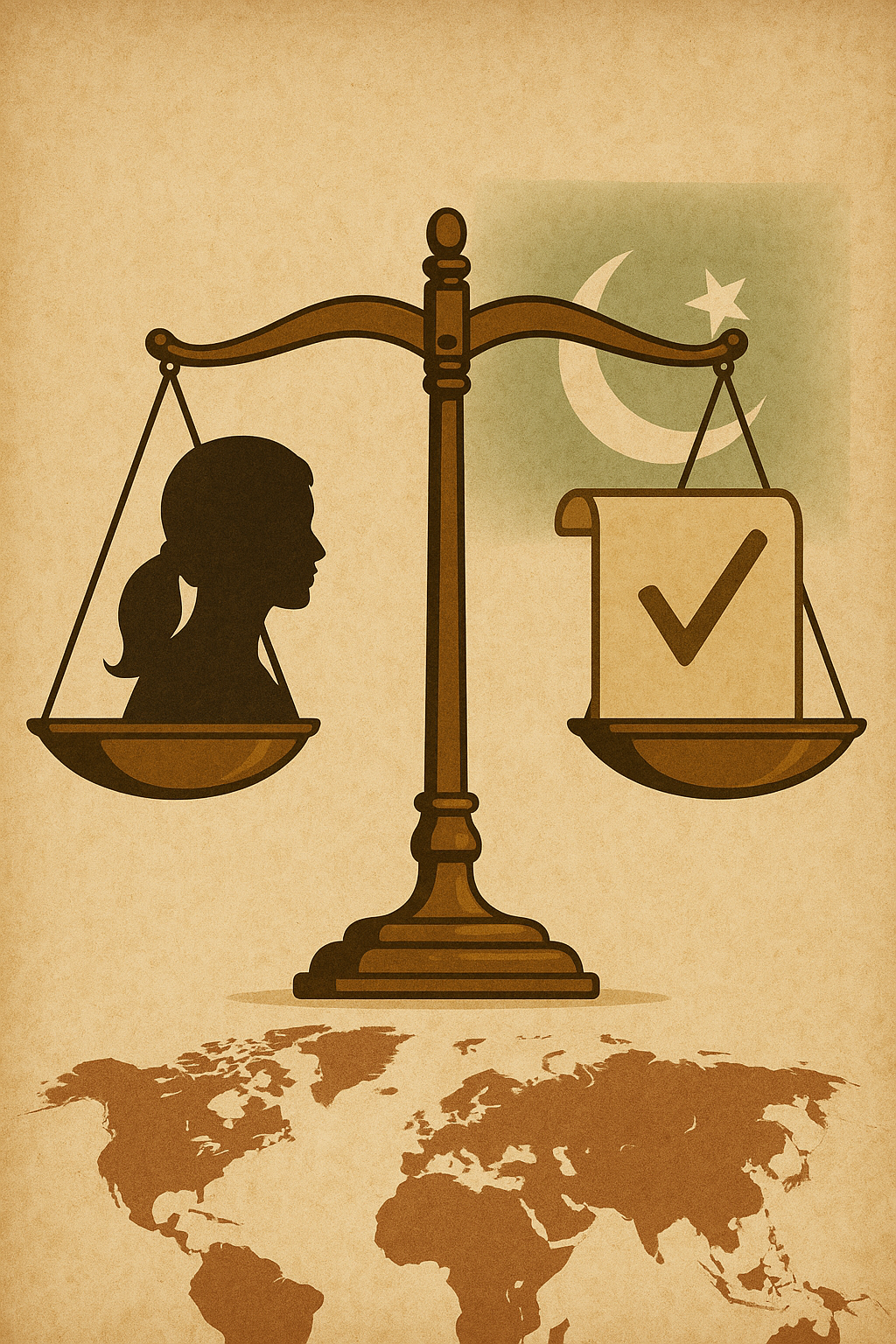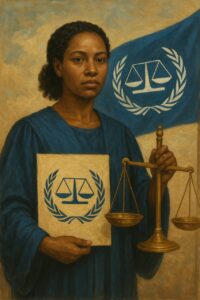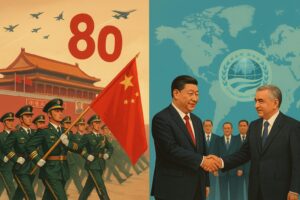From Treaty to Reality: Evaluating Women’s Rights, Reforms, and Resistance in Pakistan

A symbolic illustration reflecting Pakistan’s journey from legal frameworks to lived realities of women’s rights, reforms, and resistance.
Abdul Sattar Edhi says that “you have to care for all beings created by God”. But our society seems to have deviated from this saying. Ensuring dignity, equality, and freedom aside from gender, race, color, religion, and any belonging is the main focus area to be addressed by international human rights law. The basic rights of women are ensured by universal frameworks such as the Universal Declaration of Human Rights (1948),The Convention on the Elimination of all forms of Discrimination Against Women (CEDAW, 1979), International Covenant on Civil and Political Rights (ICCPR), and International Covenant on Economic, Social and Cultural Rights (ICESCR). It means that equal and basic rights for women are truly declared in international law. Despite having such well-defined global standards of rights for women, they are still facing marginalization, exclusion, and violence.
Recognizing women’s rights as human rights is the only way forward to reclaim justice and equality in response to gender and identity-based discrimination to rejuvenate the so-called claim that we have ensured the rights of women to the same level as of men. Unfortunately, international law is not a proper law due to the lack of implementation power like domestic law, and these laws are implemented through its subjects i.e. states. The state of Pakistan is considered one of the disobedient subjects regarding the implementation of international human right laws, particularly in the case of gender-based discrimination.
According to the World Economic Forum’s Global Gender Gap Report for 2024, Pakistan was placed at 145 out of 146 states which is a decline compared to 142 in 2023 . This low level of global ranking reflects the vulnerability and violations of Human rights in Pakistan. Although Pakistan also has some domestic laws, for instance, the section 375 (375A), 376 (376A) and section 509 of the Pakistan Penal Code to avert gender based crimes, but having laws limited to the papers means next to nothing. This article tends to explore and analyze the legal rights, their violations, national and international commitments, and implementation challenges in Pakistan. As despite global commitments and progressive legislation, Pakistan struggles with ensuring the rights of women due to systemic, societal, and institutional barriers.
Article 1 of the Universal Declaration of Human Rights declares that All human beings are created equal and free in rank and rights. While Article 2 describes that all human beings are entitled to the privileges and rights set forth by this Declaration, regardless of the difference of religion, color, gender, language, ethnic, national, political or social origin, birth, property or other belongings. Someone can infer easily from these articles that UNDHR gives equal rights to women as to men. Another landmark international treaty is CEDAW (Convention on the Elimination of all forms of Discrimination against women) implemented in 1979 by UN General Assembly aims to eject all types of discrimination against women.
The CEDAW states in its first article that each type of distinction, restriction, or exclusion made on the basis of sex which has the effect or purpose of impairing or nullifying the recognition, enjoyment or exercise by women of human rights and fundamental freedoms is considered as gender discrimination. While in the second article, CEDAW obliges countries to eliminate discrimination through legislation, institutions, and policies. International Covenant on Civil and Political Rights (ICCPR) also clearly defines that women have equal rights as of the men in a society. Article 2(1) of ICCPR talks about nondiscrimination while article no: 3 of the covenant secures the same rights of men and women to the enjoyment of all political and civil rights framed by the covenant.
Pakistan has also formally ratified the international commitments related to gender equality and human rights that reflects acknowledgement global standards of laws against discrimination by the authority of the country. Major treaties of human rights like CEDAW, ICCPR, and ICESCR are those which are warmly ratified and promised to be followed by the state of Pakistan. However, its compliance with the obligations under these treaties has remained inconsistent due to internal obstacles, particularly the influence of patriarchal interpretations of Islam, politicization of religion, and the power held by conservative religious clerics who resist reforms perceived as western or contrary to traditional family structures.
For example, issues like inheritance equality, freedom of movement, and gender roles in public life often face resistance rooted in conservative religious ideologies. These reservations, which are based on socio-religious dynamics, have also drawn international criticism for allowing women discrimination to persist under the pretext of cultural relativism. Despite these challenges, Pakistan has taken part in the Universal Periodic Review (UPR) of the Human Rights Council of United Nations, accepting several gender-related recommendations, including those promoting legal reforms for women.
National legal framework of Pakistan has gradually evolved to prevent discrimination and violence against women, particularly through the enactment of specific laws for protecting women’s rights. Act no.6 of 2010 of the Pakistani constitution states that the constitution of the Islamic republic of Pakistan recognizes the basic rights of citizens to dignity of person and whereas it is expedient to make this provision for the protection from harassment of women at workplace .
The next is The Anti-Rape Act, 2021 (Investigation and Trial), a Pakistani law designed to provide swift justice for sexual offenses, establishing special courts and investigative procedures. Provincial legislative bodies are also trying to bring forth laws and reforms regarding women rights in Pakistan. For instance, violence against Women Bill, 2021 (Prevention and Protection) has been passed by the Khyber Pakhtunkhwa Provincial Assembly on 15th January, 2021. Along with these, there are many women protection bills in Pakistan like the Protection of Women Act, 2006 (Criminal Laws Amendment) and the bill passed by the Punjab provincial government, Protection of Women against Violence Bill, 2015.
Despite our domestic legislative process and international commitments, the violations such as rape cases, honor killing, forced marriages, and domestic violence remain widespread and culturally normalized in many areas. The report of the National Police Bureau reveals almost 405 cases of honor killing during the last year. Domestic violence allegedly accounted at least 3,385 cases of beating, and 1,641 cases of murder. While the sexual assault cases continued unabated, data from police pointing to a total of 4,175 cases of rape, gang rape accounted for 733, 24 of custodial sexual attacks and 117 cases of sexual violence reported within the households.
According to the information received by the Digital Rights Foundation, the cases of cyber-harassment were 3,121, the majority of which were registered by women in Punjab. According to the report of SSDO (2024) on Mapping gender-based violence in Pakistan, 5339 cases of rape, 547 cases of honor killing and 2238 cases of domestic violence were reported across Pakistan. The most recent case of domestic violence is reported from Jhang on Sunday, 3rd August 2025 in Dawn, where a lady doctor was murdered by her brother for refusing to serve food.
While the digits of forced marriages are shocking. According to The estimate of United Nations Children’s Fund (UNICEF), almost 18.9 million girls are married before the age of 18 and 4.6 million before 15 in Pakistan, mostly done by force, which is a tragedy. These huge statistics of women’s rights violations clearly indicates the persistent gap between international and domestic commitments of the state and their practical implementation on the ground to hold the safety and security of women against any form of discrimination.
When we trace back the causes behind this gap, we come to know that there are some entrenched barriers to the implementation of justice and reforms in Pakistan. They include fragile implementation mechanisms, institutional weaknesses, lack of political will, socio-religious resistance, and societal stigma and discrimination. The combined effect of these barriers creates a hostile environment for victims seeking redress and dilutes the impact of legal reforms. Without confronting these structural and attitudinal challenges, the promise of gender justice remains largely symbolic rather than transformative. Ensuring women’s rights in our society needs us to combat these deep-rooted hurdles. The following recommendations can be helpful in chalking down a counter strategy to these barriers and for the advancement of women’s rights in Pakistan.
Recommendations
- Socio-religious conservatism should be countered by awareness campaigns
- The textbook boards should introduce a comprehensive gender equality curriculum
- State, civil society members, and human rights activists should engage community leaders and religious representatives as well as work for strengthening institutional framework
- The reform process should be continued
- The state should promote economic empowerment and education of women
To sum up the discussion, these issues are not merely legal deficiencies but reflect systemic failures that are perpetuated by societal stigma, weak political will, and lack of institutional capacity. If Pakistan is to honor its international obligations and create a truly just society, it must move beyond symbolic reforms toward substantive change, where justice is not only promised, but delivered. Bridging the gap between treaty and reality requires a multifaceted approach: legal reform, education, cultural transformation, and above all, the political courage to confront oppressive power structures that hinder progress. Only then can the fundamental principle, that the rights of women are the rights of humans, be realized in its fullest sense.



